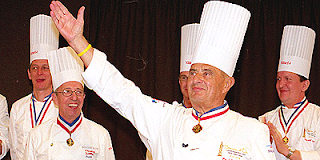We're having two of our best friends over for a pre-Christmas dinner this evening -- something we do with these friends every year. A pork loin roast is headlining the menu, and I have just taken the apple-sweet potato casserole out of the oven. It smells heavenly.
The recipe? It's quite simple.
4 medium to large-sized sweet potatoes
5 tablespoons of butter
1-1/4 cup of unsweetened applesauce
1 tablespoon of nutmeg, freshly grated
2 tablespoons of cinnamon
1 teaspoon of allspice
granulated sugar (to your taste)
1 tablespoon of apple-jack brandy or calvados
2 eggs
Optional: chopped walnuts or pecans
Preheat oven to 350 degrees. Peel the sweet potatoes, cut them into chunks and then bring them to boil in a pot of water. Reduce to a simmer and continue until the potatoes are cooked through.
Drain the sweet potatoes and set aside. Place the butter, cut up into a few pieces, in the bottom of a stainless steel bowl. Pour the sweet potatoes on top and begin mixing with a hand beater (a large mixer can also be used) until the butter is incorporated into the sweet potatoes.
Now add the applesauce and continue beating until the apple-sweet potato mixture is smooth. Add the nutmeg, cinnamon and allspice, beating the mixture to incorporate the spices. Add the sugar, starting with a 1/2 cup and then tasting before adding more until you get it right. (Why don't I specify an amount of granulated sugar to add? Because sweet potatoes and applesauce can vary widely in their sweetness.)
Now add the apple brandy and mix it into the apple-sweet potato mixture. Then beat two eggs into the same mixture until well incorporated -- at least one full minute. Pour the apple-sweet potato mixture into an ungreased casserole dish and bake for 30 minutes.
Optional: sprinkle chopped walnuts or pecans on top. Allow it to cool a little, then serve.
 An article in a recent issue of Fine Cooking magazine offers some suggestions for cooking with sage, which happens to be one of my favorite herbs. One of the cooking suggestions sounds quite tasty, yet nutritionally sound:
An article in a recent issue of Fine Cooking magazine offers some suggestions for cooking with sage, which happens to be one of my favorite herbs. One of the cooking suggestions sounds quite tasty, yet nutritionally sound:








